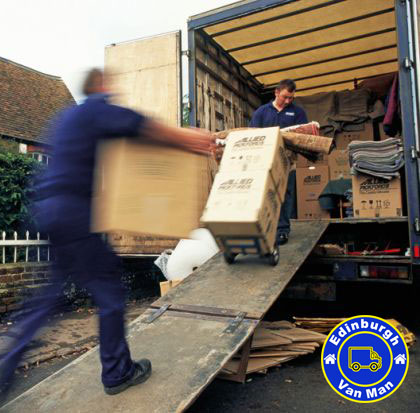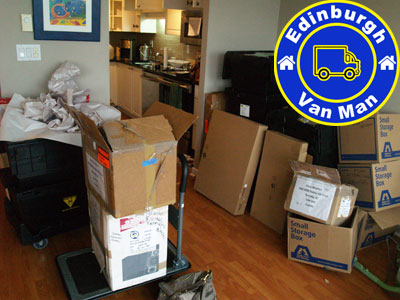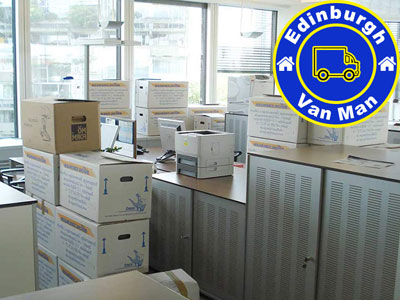Moving Advice
Planning, Packing and Moving In
Start planning your move as soon as you have decided on the removal date. Begin by getting rid of all unwanted items: charity shops and selling on Gumtree and eBay are good places to get rid of things; the rest can go to the local rubbish tip – here at Edinburgh Van Man we can collect your unwanted furniture etc and take it to the local refuse collection centre at Sighthill or Seafield. Alternatively, you can request a collection of bulky items via Edinburgh Council website. There is a fee charged for each item up to 5 items.
If you do not have too many possessions, we provide a small removals service that is very affordable, and we do all the hard work moving your stuff. Or you can hire a van and do your own removal – driving, loading and unloading, perhaps aided by friends or family. Vans are available in various capacities for hire on a daily basis. With an ordinary driving licence, you can hire a van up to 7.5 tonnes.
Estimate the size carefully you will need, and try to make the move in one journey, returning the van immediately afterwards. Allow plenty of time for loading and unloading – it takes longer than you think as well as for journey time.
If however, you are moving the full contents of a home, you need to employ an experienced removal company like Edinburgh Van Man. The best are found by personal recommendation or check Google local listings for a reliable company that has lots of 5-star reviews.
Getting an estimate
The company will send an estimator to decide what size of van is required; make sure that he knows exactly what is to be moved. Forgotten items that involve an extra journey can bring additional charges.
Go through the house with the estimator, pointing out any fittings – such as carpets and curtains – that you are leaving behind. He will tell the removal foreman, but as an extra precaution, label all items to remain, Not to be removed. The estimator will also ask if you are doing your own packing, or want it done by the removers. This will cost extra but may be worthwhile if you are short of time to do your own, for example, if you are self-employed.
If you are taking fitted carpets with you, ask the estimator if they can be lifted by the removal company in advance, or if you must do it yourself. The removal men will not take up fitted carpets on moving day; they will only roll them up and carry them out. They will not refit them.
Fix a date and time of removal with the estimator. Removal firms usually offer insurance at about 10 per cent of the removal charge, but it may be cheaper to obtain a temporary extension of your home contents insurance.
The removal company will send you a written quotation: check it carefully for date and time, then confirm your acceptance and ask the company to confirm in writing. Once agreed in writing, it becomes a contract and its terms cannot be altered, except for any special provisions in the quotation. Check that these are fair and reasonable before signing.
Packing
The removal company will provide packing cases free: use them to pack china and glassware, double wrapped in newspaper. Collect strong cardboard boxes for other items and use plastic dustbin liners for linen, bedding, and curtains.
You must take down curtains, fixtures and fittings, and dismantle self-assembly furniture.
Pack clothes in suitcases and garment bags, but small items can be left in their drawers. To transport pot plants, make a metal foil tray and place it in the bottom of a cardboard box. Water the plants thoroughly and put them in the box on the day of the move.
Pets cannot be taken in the removal van – you must take them with you. CATS can be taken in cartons available from a pet shop; birds can be carried in their cages; goldfish in a plastic bag containing ten times as much air as water. Tropical fish can also be placed in plastic bags, but put the bags in cardboard boxes and fill the spaces with expanded polystyrene chips or granules to maintain the temperature. If the journey is long, the fish may have to be tranquillised by a vet, as stress can kill them.
Pack delicate equipment such as TV’s, game console’s and computer gear in their original boxes, if possible, or get boxes that are a close fit and pack them with newspaper.
Run down the contents of your fridge and freezer and defrost as near to removal day as is convenient. A freezer can be kept in use if you are moving only a short distance – the contents will keep without thawing for up to eight hours. Arrange to have it loaded last and taken off first so that it can be quickly reconnected.
Gas appliances permanently connected to a supply, such as your cooker, must be disconnected by the gas board or an approved gas fitter. Arrange for him to call on the morning of the move, and for reconnections at your new home. You may also want an electrician to disconnect electrical appliances.
At the same time arrange for the gas and electricity meters to be read – you will then be charged only for units used up to that time. If you have a telephone, notify the sales office of the telephone company of your move, so that they can make up your final bill. If you are moving only a short distance, you may be able to retain the same number.
Other people, you need to notify include the local council for council tax, your employer, bank, credit card companies, insurance companies, Inland Revenue, Department of Social
Security and any clubs or organisations of which you are a member. Send your car registration document to the Driver and Vehicle Licensing Centre, Swansea SA99 1AB. Send your driving licence to the same address, with your new address filled in on the reverse side of the licence.
The Post Office needs seven days notice to redirect your mail. Fill in Form P3575, available from post offices, and your mail will be redirected for up to a year for a small charge. Remember also to cancel milk, newspapers and any other regular deliveries.
Moving out
Before removal day, make a room-by-room plan of your new home, numbering each room. Then number the articles to be moved, so that the removal men know where each piece goes. Give the plan to the removal foreman when the van arrives.
Before it leaves, make sure the driver knows the way; give him a rough map if he does not, and tell him of any access or parking problems there. If there are parking restrictions outside the house, tell the remover in advance, so that they can arrange police cooperation.
Give the foreman the house keys if you are not travelling ahead, though it is best to be there first if you can.
At your old home, have a final check to see that everything has been loaded before the van leaves, then shut all windows and turn off the water at the stop valve and the electricity at the consumer unit. Leave a note for the new owners explaining what you have done. Hand over the keys to the new owner or estate agent. As soon as possible after the move, check the condition of your goods: any claims for damage or breakages must be made within seven days.
